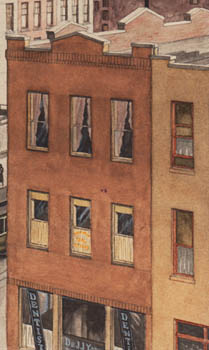Description
The watercolor was painted only one year after the Empire State Building had officially opened. As the tallest building in the world it stood as a symbol of American technological achievement and an Art Deco icon of New York City. At the time of the painting, it did not yet have the large antenna tower on the top that we associate with it now — that was not erected until the 1950s.
Walter Hood McKay was a designer and painter based in New York City. Born in Ohio, he studied at the Art Institute of Chicago and the Art Students League. In the 1930s he exhibited at the Barbizon Plaza Hotel and the Tricker Gallery, but specialized in illustration and advertising art. In the 1940s and 1950s, he also designed typefaces, including Columbia, which was produced by the Amsterdam Type Foundry between 1949 and 1956. An illustration by McKay of Alexander Graham Bell inventing the telephone was sold by George Glazer Gallery to a private collection in the 1990s.
References:
Falk, Peter Hastings, ed. Who Was Who in American Art. Madison, Connecticut: Sound View Press, 1985. p. 409.
Haskett, Thomas R. “Broadcast Antennas on the Empire State Building.” Broadcast Engineering. August 1967, pp. 24-31. Online at L.N.L. Electronic Distributors. http://www.lnl.com/esbantennas.htm (10 October 2011).
Middendorp, Jan. Dutch Type. Rotterdam: 010 Publishers, 2004. p.89. http://books.google.com/books?id=sR9g5xPPJVQC (7 October 2011).











